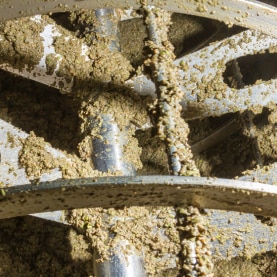Sunflower oil
Sunflower oil accounts for a significant proportion of global oilseed production. Like other oils, it was obtained in the past by pressing. Industrial production consists of two main stages: seed pressing and oil refining. Sunflower oil is valuable on a nutritional level, as it is rich in essential fatty acids, but also from a dietary point of view because it is stable when heated and has a neutral flavour.
Oilseed production, a dynamic, high-growth sector
Over recent decades, the production of oilseed crops has grown twice as fast as global agriculture. Sunflower, palm, soybean and rapeseed oils represent three quarters of the worldwide production of oil, while cottonseed, peanut, coconut, olive and sesame oils represent just one quarter.
Due to their high energy content, oilseeds have contributed to the increase in dietary energy intake in developing countries over recent decades. This trend is set to intensify in the future. By 2030, 45% of additional calories could come from oilseeds.
Industrial sunflower oil production processes
The hydraulic press was long used to obtain sunflower oil. Nowadays, the oil is mainly produced industrially using expeller presses. The production process comprises two main stages: seed pressing and crude oil refining. Pressing extracts the oil from the seeds while refining eliminates the compounds that affected the smell, flavour and appearance of the oil during pressing.
To prepare the seeds for pressing, a series of operations must be carried out. The seeds are firstly cleaned by sieving (rotating or vibrating sieves) and by magnetic separation, to eliminate the impurities (stems, leaves, stones, pieces of metal). The seeds are generally ground in a hammer or fluted roller mill, along with the hulls, as these cannot be reused. Once ground, the seeds are crushed between smooth rolls, then heated in cookers at 88°C to sterilise them. After cooking, the seeds are dried at 110°C to dehydrate them and harden their structure. When ready for pressing, they are placed under an expeller press and heated to between 80°C and 120°C to extract the oil. The residue, called oil cake, is treated with a solvent or water to also extract oil. Unlike industrial hot pressing, cold pressing is a purely mechanical process with no added heat or refining. The pressing temperature does not exceed 60°C. This produces oil with a more intense flavour and smell.
Once the oil has been obtained, the refining process involves several treatments: degumming, neutralising, bleaching, deodorising and anti-oxidising. Degumming removes the compounds which may affect the flavour and helps improve the stability of the oil when heated. Various treatments exist: water, acid and dry degumming. Neutralising removes the free fatty acids, usually by adding sodium hydroxide which turns them into soap. Once neutralised, the oil is washed in water to eliminate any residual soap. The pigments in the oil are removed with activated carbon, silica or oxidants. The oil is then filtered or centrifuged to remove the wax. Finally, to improve the oil’s shelf-life, water in the form of gas (dry steam) is injected into the oil, while it is maintained under vacuum at high temperatures (220°C to 275°C) for between 1.5 and 3 hours.
Sunflower oil for cooking
The neutral flavour of sunflower oil and its stability when heated mean it can be used cold in salad dressings or hot for cooking food at high temperatures. It is also ideal for making margarine. If heated beyond 210°C, the oil must not be consumed, as it releases toxic and carcinogenic compounds.
Nutrition
Lacking in proteins and carbohydrates, sunflower oil contains lipids and vitamins (E and K). A tablespoon of sunflower oil (15 ml) provides 122 kilocalories. Sunflower oil is rich in linoleic acid (a polyunsaturated omega-6 fatty acid), essential for humans as we are unable to synthesise them ourselves. It also contains oleic acids but has a relatively low amount of omega-3 fatty acids.
D’AMICO, Serge, 1999. Graisses et huiles. Le guide des aliments. Montréal : Québec Amérique. 1999. pp. 152-155.
EUFIC | Conseil Européen de l'Information sur l'Alimentation, 2009. Les graisses saturées sous la loupe. EUFIC | Conseil Européen de l'Information sur l'Alimentation. Mars 2009. [Consulté le 18 décembre 2015]. Disponible à l’adresse : http://www.eufic.org
FAO | ORGANISATION DES NATIONS UNIES POUR L'ALIMENTATION ET L'AGRICULTURE, 2004. Perspectives par grand secteur. Production végétale. Agriculture mondiale : horizon 2015/2030. Rapport abrégé. ONUAA | Organisation des Nations Unies pour l'alimentation et l'agriculture. Rome. 2004. pp. 32-38. [Consulté le 18 décembre 2015]. Disponible à l’adresse : ftp://ftp.fao.org
KARTIKA, Ika Amalia, 2005. Nouveau procédé de fractionnement des graines de tournesol : expression et extraction en extrudeur bi-vis, purification par ultrafiltration de l’huile de tournesol [en ligne]. thèse de doctorat. INRA | Institut national de la recherche agronomique. Laboratoire de Chimie Agro-Industrielle. [Consulté le 10 décembre 2015]. Disponible à l’adresse : http://ethesis.inp-toulouse.fr
OFFICE FÉDÉRAL DE LA SANTÉ PUBLIQUE. DIVISION SÉCURITÉ ALIMENTAIRE. SECTION RISQUES NUTRITIONNELS ET TOXICOLOGIQUES, 2012. Les graisses dans la nutrition. Mise à jour des recommandations de la Commission fédérale de l’alimentation. Complément au rapport d’experts « Les graisses dans la nutrition » comprenant les recommandations actualisées. Office fédéral de la santé publique. 30 septembre 2012 [Consulté le 18 décembre 2015]. Disponible à l’adresse : http://www.cusstr.ch
PAGES, Xavier, MORIN, Odile, BIROT, Céline, GAUD, Marie, FAZEUILH, Stéphane, GOUBAND, Morgan, 2010. Raffinage des huiles et des corps gras et élimination des contaminants. OCL | Oilseeds and fats, Crops and Lipids. Mars-avril 2010. Vol. 17, n° 2. pp. 86-99 [Consulté le 18 décembre 2015]. Disponible à l’adresse : http://www.ocl-journal.org
VITAUX, Jean, FRANCE, Benoît. 2008. Huile. Dictionnaire du gastronome. Paris : Presses Universitaires de France. 2008. pp. 472-473.





